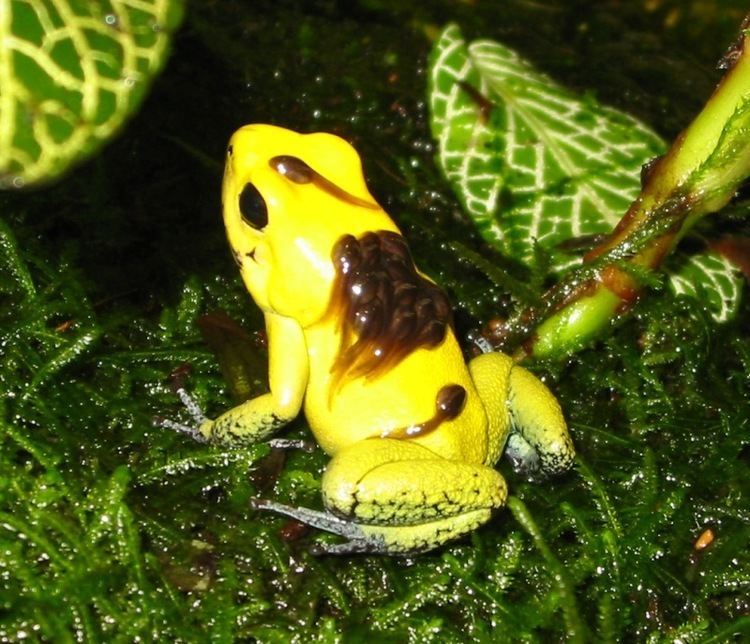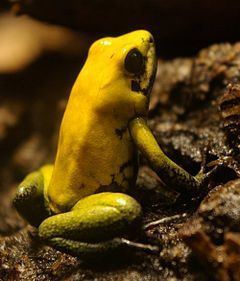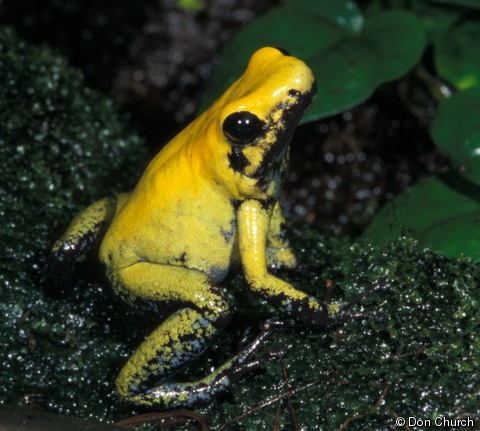Order Anura Family Dendrobatidae Rank Species | Phylum Chordata Suborder Neobatrachia Genus Phyllobates Higher classification Phyllobates | |
 | ||
Similar Phyllobates, Frog, Poison dart frog, Phyllobates aurotaenia, Golfodulcean poison frog | ||
Group of courting phyllobates bicolor
Phyllobates bicolor, also known as the black-legged poison frog, bicolored dart frog or neari in Choco, is the second-most toxic of the wild poison dart frogs. This species obtained its name due to its normally yellow or orange body with black or dark blue hindlegs and forelimbs below the elbow. It lives in the lowland forests in the Chocó area in western Colombia, along the San Juan River.
Contents
- Group of courting phyllobates bicolor
- Dart frog connection s phyllobates bicolor green leg
- Description
- Toxicity
- Behavior
- Captive care
- References

In this species, the male transports tadpoles adhering on its back.
Dart frog connection s phyllobates bicolor green leg
Description

Phyllobates bicolor is one of the largest poison dart frogs. Males can reach a length of 45–50 mm from snout to vent, while the slightly larger females reach 50–55 mm in length from snout to vent. P bicolor ranges in color from earthy orange to pure yellow in coloration, often with a blue or black tinge on their legs, hence their name. They are smaller and more slender than their close relative, Phyllobates terribilis, and can resemble juvenile or subadult P. terribilis frogs. They also bear a resemblance to D. leucomelas, particularly the "netted" color morph of D. leucomelas.
Toxicity

While its toxicity is weaker than P. terribilis, P. bicolor is still a highly toxic animal, one of the few frogs confirmed to have caused human fatalities. Just 150 micrograms of its poison is enough to kill an adult human. This frog is often heated over a flame to make it "sweat" the liquid poison for hunting darts. The poison causes death by respiratory and muscular paralysis. Research is being conducted to determine medicinal uses for this batrachotoxin. As with all dart frogs, captive-raised individuals are not toxic; the animals require chemicals found only in their wild food sources, mainly insects. In captivity, these chemicals are not available to them from their food sources.
Behavior

Like many of the Phyllobates genus, P. bicolor is mostly terrestrial, only taking to the trees when rearing young. Most are solitary animals, however wild groups can be found occasionally. Unlike many frog species, both males and females can be vocal, producing high-pitched, bird-like calls. The black-legged poison dart frog is mostly diurnal, retreating into the cover of the leaf litter at night. While most individuals are solitary, during the wet season, P. bicolor frogs, like all dendrobatids, gather in large breeding groups. One of the more dedicated of parents among anurans, P. bicolor males carry their tadpoles on their backs. The tadpoles stick to the mucus on the backs of their fathers, and are transported to puddles. There they are fed and protected until they become froglets, at which point they are completely independent, and leave to begin their adult lives.
Captive care

Care for P. bicolor is similar to P. terribilis, except P. bicolor can be kept in a slightly smaller enclosure.
